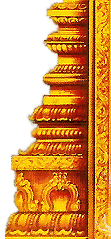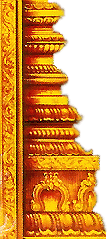|
|
Home >>
274 Sivalayam >
sri Kalathiappar temple
|
| |
- Details
- Path
- Map
- Photos
- Near By Temple
| |
| |
|
![[Image1]](http://img1.dinamalar.com/Kovilimages/T_500_1009.jpg)
|
| | |
| | | |
|
|
|
Moolavar | : |
Kalathiappar, Kalatheeswarar |
|
|
Urchavar | : |
- | |
|
Amman / Thayar | : |
Gnanaparasunambikai, Gnanapoongothai,Gnanasundari | |
|
Thala Virutcham | : |
Vilwa | |
|
Theertham | : |
River Ponmuhali (also Swarnamukhi river) | |
|
Agamam / Pooja | : |
- | |
|
Old year | : |
2000-3000 years old | |
|
Historical Name | : |
Seekalathi | |
|
City | : |
Kalahasthi | |
|
District | : |
Chittoor
| |
|
State | : |
Andhra Pradesh |
| |
|
|
| |
|
|
 | Singers: |  |
| |
|
|
| |
Appar, Gnanasambandar and Sundarar This is the 19th temple on the Cauvery bank praised in Thevaram hymns in the Thondaimandalam region. |
|
| |
|
|
 |
Festival: |
 |
| |
|
|
| |
Masi festival in January-February, Mahasivarathri in January-February, Thirukarthigai in November-December, Oonjal festival on all Fridays, Makara Sankranthi (Pongal) in January and Giri Valam on Shivrathri day. |
|
| |
|
|
 |
Temple's Speciality: |
 |
| |
|
|
| |
Sri Kalathinathar is a Swaymbumurthi blessing the devotees. As Kalahasthi belongs to the Vayu (wind) nature of the Panchaboodha shrines, the lamp in the sanctum sanctorum will be always oscillating. |
|
| |
|
|
 |
Opening Time: |  |
| | | | | |
The temple is open from 5.00 a.m. to 12.00 a.m. and 5.00 p.m. to 9.00 p.m. |
|
| | | |
 |
Address: |  |
| | | | | |
Sri Kalathiappar Temple, Kalahasthi, Andhra Pradesh. |
|
| | | |
 |
Phone: |  |
| | | |
| |
+91 8578 222 240 | |
|
| | |
 |
General Information: |  |
| |
|
|
| |
An idol of Kannappar is installed in the Mandap adjacent to the sanctum sanctorum. There are two Nandhis (bull vehicle of Lord Shiva) in front of the presiding deity, one made of white stone and other of brass. The sanctum sanctorum is constructed in the shape of an Agazhi – a deep and broad water defence arrangement around the palaces of the kings to prevent entry of enemies. There are Ganapathi, Dakshinamurthi, Lingodhbhava, Brahmma, Durga on the inner corridors. There is a metal covered flag post and also a 60 feet tall flag post made of a single stone. There are also a Balipeeta and Nandhi in front of the temple. |
|
| |
|
|
 |
Prayers |  | |
|
| | | |
Of the nine planets, Kalahasthi’s importance is attached to Rahu and Ketu (Dragon’s tail and head respectively) those afflicted with the adverse effects of these planets and problems related to snakes, pray for relief here. | | |
|
| |  |
Thanks giving: |  | |
|
| | | |
After fulfillment of the prayers, devotees perform Abhishek to the Lord, offer Vasthras (clothes) and also offer donation for the maintenance of the temple depending on their affordability. | | | |
| |  |
Greatness Of Temple: |  |
| |
|
|
| |
Kalahasthi temple is closely attached with the history of Kannappar, whose bhakti (devotion) is yet to be equaled in the history of the religious literature of Tamilnadu. Acharya Shankara had devoted a verse in praise of Kannappar in his celebrated Shivanandalahari. Sekkiizhar, in his Periapuranam elaborately sings the greatness of Kannappar in 185 verses. Kannappar performed abishek to the Lord bringing water from the Swarnamukhi river in his mouth. Vibhuti Prasad is not offered in this temple, but symbolizing the Abishek Theeratha of Kannappar, only Theertha Prasad (water) is offered to the devotees mixed with Pachai Karpooram. It is offered through a conch. The Vibhuti (sacred ash) brought by the devotees are placed at the feet of the Lord, an arati is offered and returned to the devotee. Abishek is performed to the Lord only with water mixed with Pachai Karpooram. Other Abisheks are offered only to the stage (called Avudayar – the Linga Peetam) As the Shrine is related to Rahu-Ketu planets, devotees do the pradikshana in an anti-clockwise way. As sage Bharadwaja performed penance here, only those belonging to the Bharadwaja Gotra are appointed as archakas in the temple. The Kavacha covering the Lord has the symbols of the planets, hence there is no separate shrine for the Navagrahas except for Saturn. Garlands are not offered on the body of Lord. An angi – upper cloth – is placed on the Lord on which Thumba Flower Garland is placed. In the Oddiyanam (belt made of gold studded with pearls and precious stones), of Mother Gnanaprasunambikai, the symbol of planet Kethu is carved. There is a temple for Lord Manikandeswara on the slopes of the hill through which Kannappar went on the hill taking his Abishek Water from Ponmuhali river. There is also a mandap called Manikarnika Gattam near this temple carved out of the hill. The story goes that it is here Lord Shiva uttered the Tharaka Mantra to a women (commonly known as Karna Manthra being uttered on the ears of the departing soul) as Lord Viswanatha did in Kasi – Varanasi to a devotee. Following this tradition, devotees use to bring those nearing their end to Manikarnika Gattam and place them lying here so that the last breath may leave the mortal body through the right ear. Procession of Lord is taken from the North tower entrance. As Maharishis worshipped the Lord facing the east after a dip in the Ponmuhali river, Lord Kalathiappar is facing west to bless the Rishis. |
|
| |
|
|
 |
Temple History: |  |
| |
|
|
| |
A spider, ambitious to build a temple for Lord Shiva, did so with a threadlike material coming from its stomach. It built towers, Mandaps, the sanctum sanctorum, the pots on the tower (Kalasam), the compound wall etc. It was also doing the repairs when its threads were cut in places. To test the determined devotion of the spider, the Lord kindled up the lamp in the temple and burnt the Spider’s work. The spider, seeing its thread temple reduced to ashes, decided to fall on the fire and end itself. The Lord appeared before the spider and held the spider in His hands offering a boon. The spider begged the Lord a place at His feet in the shape of a flame. Lord granted the boon. Towards the end of Thredha Yuga, a snake named Kalan, was worshipping the Lord with precious stones on His head. An elephant named Athi also worshipped the Lord performing abishek with Ponmuhali river water and Vilwa leaves, removing the precious stones on the Lord’s head. This happened in Dwapara Yuga. The elephant and snake were both worshipping God in turn, one undoing the worship of the other. To find the enemy, the snake hid itself in the flowers placed by the elephant. The elephant, happy to see its flowers in order on the Lord began the abishek performance when the snake entered the body of the animal through the tusk and began to screw its head. Unable to bear this torture, the elephant decided to kill the creature inside and also end itself, dashed forcibly against the rocks profusely bleeding. The roaring of the elephant and the noise it made while dashing against the rocks frightened all the beings. Birds flew high. The celestial beings too were frightened. The snake was torn to pieces. Breaking its head, the elephant also breathed its last. Lord Seekalathiappar appeared on his bull vehicle with Consort Uma, granted Sarupa Mukthi (salvation) to both the snake and the elephant. The letter See in Tamil represents Silandhi the Spider, Kalam the snake and Athi (Hasthi in Sanskrit) the elephant. All combined, the place is named Seekalathi. |
|
| |
|
|
 |
Special Features: |  |
| |
|
|
| |
Miracle Based:
Lord Kalathiappar/Kalatheeswarar in the Linga form is a Swayambumurthi. As the place belongs to Vayu (wind), the lamp would be always be oscillating in the air.
|
|
| |
|
|
|
| |
|
|
|
|
| | Location :
Kalahasthi is situated 130 kms from Chennai and 40 Kms from Tirupathi. Bus facilities are available from Tirupathi, Renigunta, Kancheepuram and Tiruthani.
Those taking the rail route, can reach Kalahasthi and proceed northeast to reach the temple
Near By Railway Station :
Kalahasthi
Near By Airport :
Chennai
Accomodation :
Chennai:
Taj Coromandel: +91-44-5500 2827
Lee Royal Meridian: +91-44-2231 4343
Chola Sheriton: +91-44-2811 0101
The Park: +91-44-4214 4000
Connemara : +91-44-5500 0000
Rain Tree: +91-44-4225 2525
Ashoka: +91-44-2855 3413
Guru +91-44-2855 4060
Kanchi: +91-44-2827 1100
Shermani: +91-44-2819 4547
Kings: +91-44-2819 1471
| |
| |
|
|
![[Gal1]](http://img1.dinamalar.com/KovilImages/GalleryThumb/G_T1_1009.jpg)
|
|
 |
| அம்மன் ஞானப்பிரசுனாம்பிகை |
|
|
|
|
 |
|
|
|
|
|





